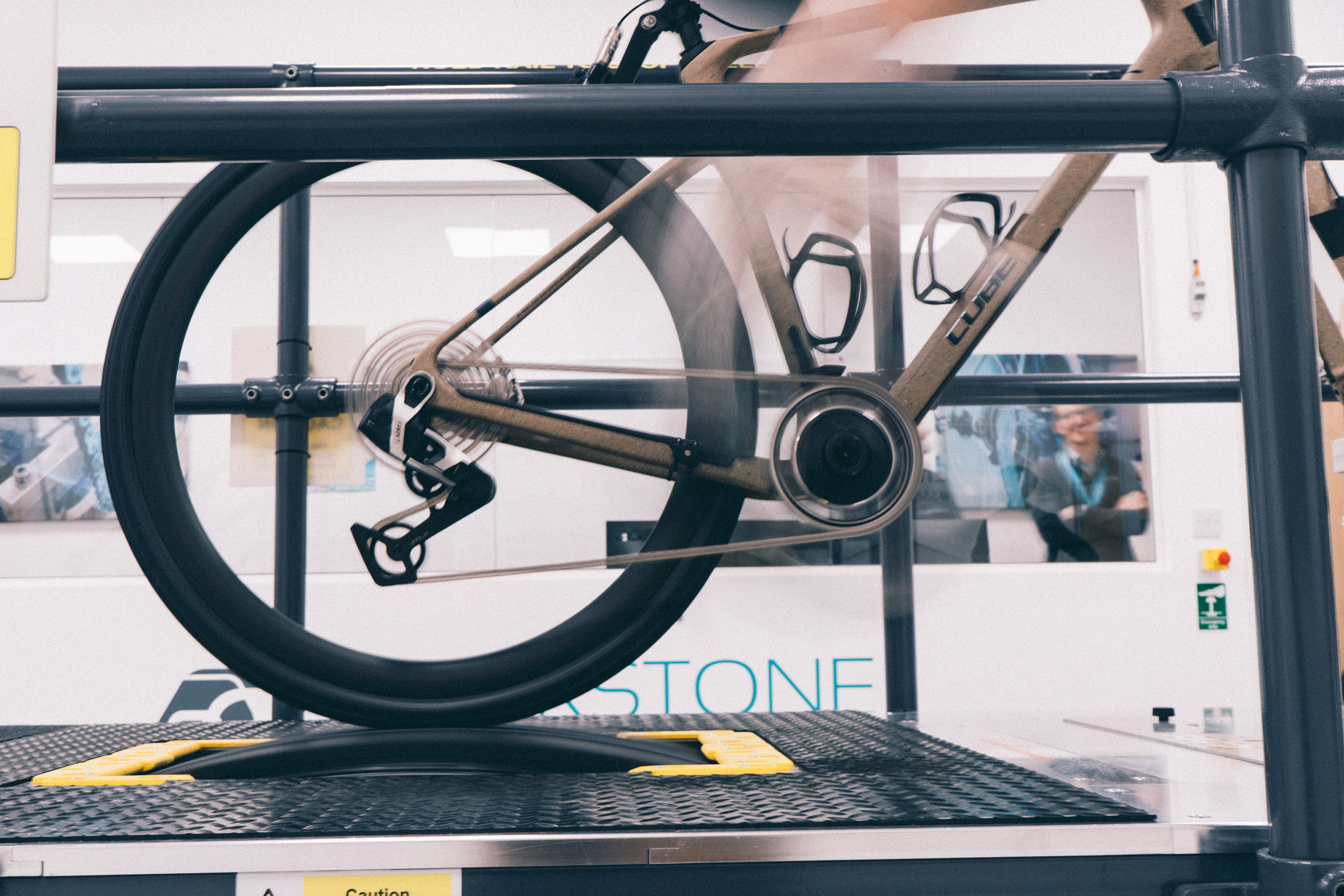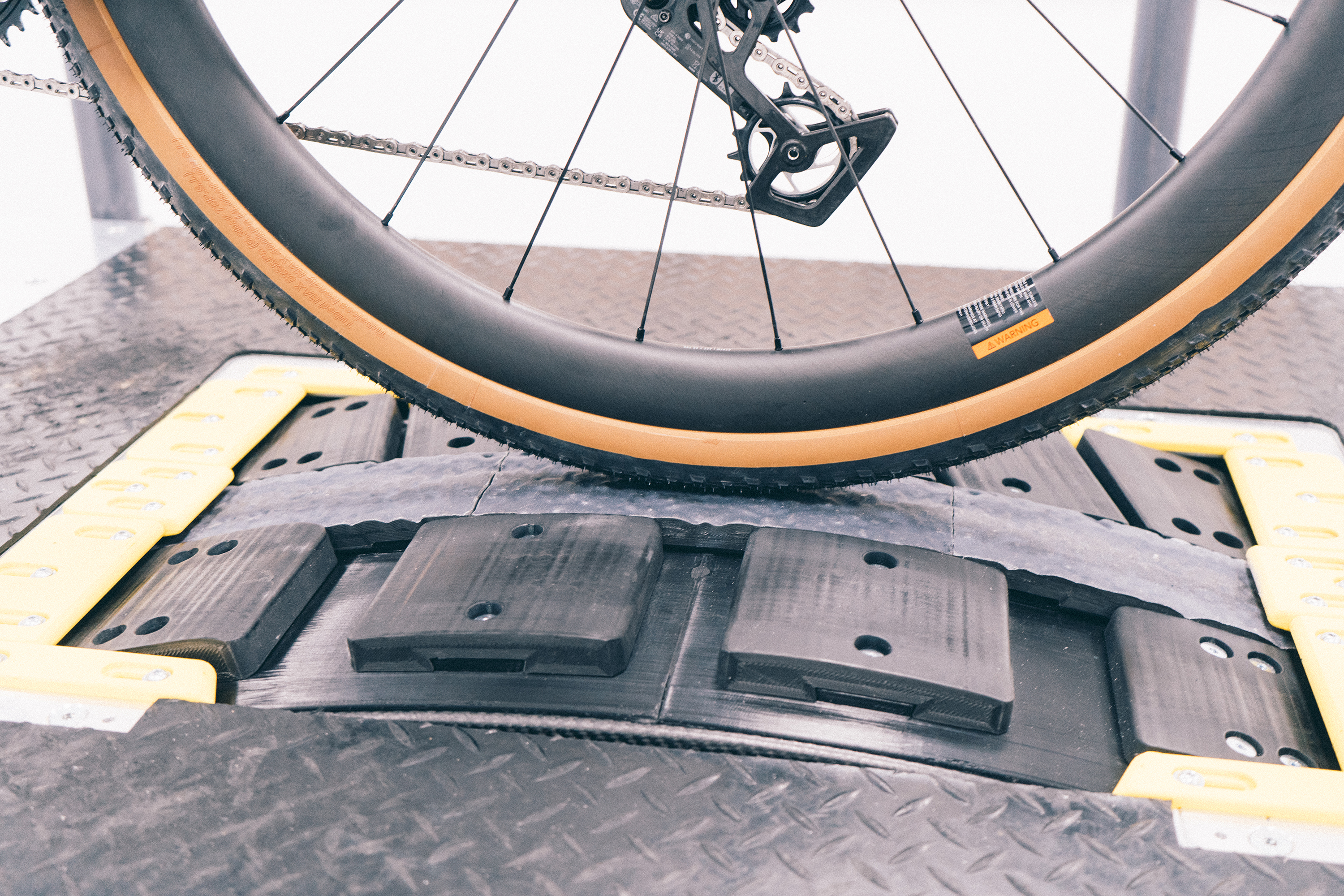Your narrow gravel tyres are slowing you down in addition to making you uncomfortable, Cyclingnews lab test reveals
Impact of changing width, tread and casing uncovered in latest instalment of CN Labs

"Wider is faster!" – They've been screaming it from the rooftops for a while, and it's not impossible to imagine marketing departments from around the bike industry having this printed on their office walls like some sort of mantra to be repeated.
I mock it, but here at Cyclingnews, we believe there's truth in it. But not ones to take the words of marketers at face value, we wanted proof, so we set out to get some.
We've been to the Silverstone Sports Engineering Hub a few times over the past year. We've tested bikes, wheels and helmets in their wind tunnel, and we've tested road tyres on its Pedalling Efficiency Rig. So for the latest instalment, we turned to gravel tyres for a lab test gravel tyre deep dive.
There's a lot of conversation about what makes the optimal gravel tyre for any given race, and of course, the answer will pretty much always be 'it depends'. On the course, the weather, the terrain, your frame, your handling skills, even who you're riding with.
It depends on the course you're riding, because a rocky course will want a tyre that can smooth out the roughness while handling the impacts, whereas a smooth course will want something that rolls, well, smoother.
It depends on the weather conditions, because a muddy course will require more grip, and potentially more clearance if the mud is likely to clog up in your frame, while a dry course is often grippy enough and clogging up is unlikely. It depends on your average speed, and whether you're riding alone or in a group, because fast or solo riders will hit more wind, and thus prioritise something with more aerodynamic performance, while slow riders, or those in a group, needn't worry quite so much.
It also depends on the likelihood of getting a puncture, because your lightweight race tyre might save you three watts in rolling resistance, but there's nothing slower than standing at the side of the road fixing the thing.
The latest race content, interviews, features, reviews and expert buying guides, direct to your inbox!
As a result, we didn't want to just spend a day testing a random cohort of gravel tyres to see which is fastest in our very specific set of circumstances. There's no real benefit in knowing that a Hutchinson Caracal – a race tyre designed for smooth surfaces – is faster than a Vittoria Terreno Wet, which is designed for cutting through sloppy mud.
Instead, we wanted to give the Cyclingnews subscribers some actionable insight every time they tackle the decision of 'what gravel tyre should I run?' – be that for a race, a long-distance adventure, or any other off-road ride.
So we set out to answer the following three questions:
1. Is wider actually faster?
Quite simply, does a wider tyre mean a reduction in rolling resistance? Because while a narrower tyre might offer more mud clearance, if you don't know how much faster or slower it is, you won't be able to make an informed decision on whether it's worth the risk.
As a result, we tested six Vittoria Terreno Dry tyres of the same construction and tread pattern, in sizes ranging from 31mm to 53mm.
2. What impact does tread make on rolling resistance?
If the terrain you're about to tackle is leaving you torn between two tread patterns, how many watts are you likely to lose by choosing the 'knobbier' tread? Or should you just switch to the grippier option to optimise for the muddy sections, safe in the knowledge that your rolling resistance differences on smoother sections will be negligible? Again, without the information, you can't make an informed decision.
Here we tested two pairs of 40mm Pirelli Cinturato tyres. The first pair in 60TPI, and the second pair in 120TPI, with the only difference between the two options being the tread pattern.
3. What impact does casing have?
Many gravel tyres come in a variety of casing options. Often this refers to the TPI count (threads per inch) but in many cases simply refers to the level of puncture protection built into the tyre's construction.
If you're unsure what TPI means, our TPI guide will explain the details, but it's generally accepted that a higher TPI count is more supple and therefore deforms more easily over rough surfaces, but often at the expense of durability, meaning potentially more punctures. The trade-off therefore is usually a question along the lines of "do I risk more punctures to gain speed?"
You can't easily answer that question without knowing how much speed you're likely to gain, and so here we used Panaracer's Gravelking tyre, which comes in a 'standard', a 'Plus' and a 'Race', each with an identical (40mm) size, and tread.

The results, which were published in our lab test gravel tyre deep dive, showed some interesting findings.
There was a definite trendline for wider tyres being faster, but it wasn't without a couple of outliers. The aerodynamic implications are yet to be tested, but it would stand to reason that a wider tyre is less aerodynamic by dint of its increased frontal area. From this inference, we can deduce that most riders - especially slower-speed riders and perhaps even those within a group setting – as often found in gravel races – would see a benefit for going wider.
The test for tread and casing were the real surprises though. We'll save the exact savings on offer for our subscribers, but both showed less of a difference than expected, meaning you could potentially be giving away speed solely in the pursuit of it.
One thing that will surprise nobody, however, is that comfort on wider tyres is significantly greater. Part of our testing day included a stint of testing on simulated cobbles, and although this is more an anecdotal conclusion than a data-driven one, riding on cobbles with narrower tyres (we went as narrow as 26mm) is not an experience I'd like to repeat any time soon!

Josh is Associate Editor of Cyclingnews – leading our content on the best bikes, kit and the latest breaking tech stories from the pro peloton. He has been with us since the summer of 2019 and throughout that time he's covered everything from buyer's guides and deals to the latest tech news and reviews.
On the bike, Josh has been riding and racing for over 15 years. He started out racing cross country in his teens back when 26-inch wheels and triple chainsets were still mainstream, but he found favour in road racing in his early 20s, racing at a local and national level for Somerset-based Team Tor 2000. These days he rides indoors for convenience and fitness, and outdoors for fun on road, gravel, 'cross and cross-country bikes, the latter usually with his two dogs in tow.
